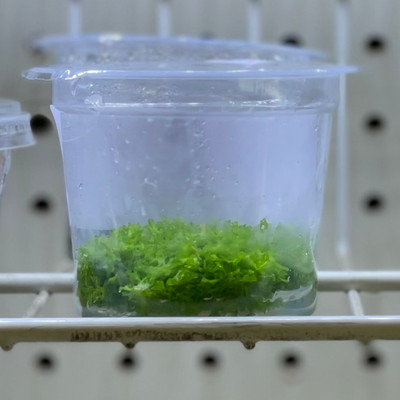Riccia Fluitans
Posted by Max Gandara on on 5th Jul 2024
Riccia Fluitans: The Floating Gem for Your Aquarium
Creating a captivating and healthy aquarium involves more than just selecting the right fish; the plants you choose play a crucial role in the overall aesthetics and ecological balance. Among the many aquatic plants available, Riccia fluitans stands out for its versatility, beauty, and ease of care. Commonly known as floating crystalwort, this plant can transform your aquarium into a vibrant, lush underwater garden.
What is Riccia Fluitans?
Riccia fluitans is a floating aquatic plant belonging to the liverwort family. It is native to various parts of the world, including Europe, Asia, and Africa. This plant is characterized by its bright green, finely branched, and delicate thallus that forms dense mats. Riccia fluitans can be used as a floating plant, or it can be attached to rocks and driftwood to create stunning underwater landscapes.
Why Choose Riccia Fluitans?
1. Aesthetic Appeal
Riccia fluitans is known for its bright green color and delicate, moss-like appearance. When allowed to float freely, it forms a dense, lush mat on the water surface. When attached to rocks or driftwood, it creates an intricate and beautiful underwater landscape, adding depth and texture to the aquarium.
2. Versatile Use
One of the most appealing features of Riccia fluitans is its versatility. It can be used as a floating plant to provide cover for fish and reduce light intensity, or it can be tied to hardscape elements to create carpets and vertical surfaces. This adaptability makes it suitable for various aquascaping styles.
3. Easy to Grow
Riccia fluitans is relatively easy to grow and maintain, making it suitable for beginners and experienced aquarists alike. It thrives in a range of water conditions and does not require CO2 supplementation, although additional CO2 will promote faster growth and a healthier appearance.
4. Ecological Benefits
In addition to its visual appeal, Riccia fluitans contributes to the health of the aquarium ecosystem. It helps in oxygenating the water, absorbs excess nutrients, and provides shelter and breeding grounds for fish and invertebrates, promoting a balanced and thriving environment.
Planting and Care Tips
1. Floating
When used as a floating plant, Riccia fluitans requires minimal care. Simply place it on the water surface, and it will form a dense mat over time. Ensure it receives adequate light to maintain its bright green color and healthy growth.
2. Attached to Hardscape
To attach Riccia fluitans to rocks or driftwood, use a fine mesh, cotton thread, or fishing line to secure small portions of the plant to the hardscape. Over time, the plant will grow and cover the surface, creating a lush, green carpet. Regular trimming is necessary to maintain its shape and prevent overgrowth.
3. Lighting
Riccia fluitans thrives in moderate to high lighting conditions. Adequate light is essential for promoting healthy growth and maintaining its vibrant color. Be mindful of the light intensity to avoid promoting algae growth.
4. CO2 and Nutrients
While Riccia fluitans can grow without additional CO2, providing CO2 supplementation will enhance its growth rate and overall health. Regular fertilization with a complete liquid fertilizer will supply the necessary nutrients, ensuring lush and vibrant growth.
5. Pruning
Regular pruning is essential to prevent Riccia fluitans from becoming too dense and blocking light from reaching other plants in the aquarium. Trim the plant regularly to maintain its desired shape and encourage healthy, new growth. The cuttings can be used to propagate new plants.
Common Issues and Solutions
1. Yellowing or Browning
Yellowing or browning of Riccia fluitans can indicate inadequate lighting or nutrient deficiencies. Ensure the plant receives sufficient light and regular fertilization to maintain its vibrant color and healthy growth.
2. Algae Growth
Algae growth can become an issue if there is an imbalance in lighting, CO2, and nutrients. Maintain a proper balance and consider introducing algae-eating fish or invertebrates to help manage algae.
3. Floating Away
If Riccia fluitans is not properly secured when attached to hardscape, it can float away. Ensure the plant is tightly secured using mesh, thread, or fishing line to prevent this issue.
Aquascaping with Riccia Fluitans
Riccia fluitans is highly versatile and can be used in various aquascaping styles:
- Floating Plant: Use Riccia fluitans as a floating plant to provide cover for fish and reduce light intensity, creating a natural, shaded environment.
- Carpet Plant: Attach it to rocks or driftwood to create a lush, green carpet in the foreground or midground of the aquarium.
- Nature Style: Blend Riccia fluitans with other mosses and plants to create a rich, natural landscape that mimics real-world environments.
Riccia fluitans is a fantastic addition to any aquarium, offering a blend of beauty, versatility, and ecological benefits. Its delicate, moss-like appearance and ease of care make it a standout plant for both beginners and experienced aquascapers. By incorporating Riccia fluitans into your aquascape, you can achieve a stunning, vibrant underwater world that enhances the beauty and health of your aquarium.

